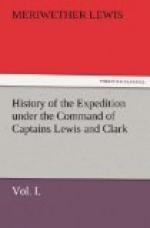Thursday, 22. This morning early two men were sent to complete the covering of the cache, which could not be so perfectly done during the night as to elude the search of the Indians. On examining the spoils which Drewyer had obtained, they were found to consist of several dressed and undressed skins; two bags wove with the bark of the silk grass, each containing a bushel of dried serviceberries, and about the same quantity of roots; an instrument made of bone for manufacturing the flints into heads for arrows; and a number of flints themselves: these were much of the same colour and nearly as transparent as common black glass, and when cut detached itself into flakes, leaving a very sharp edge.
The roots were of three kinds, and folded separate from each in hides of buffaloe made into parchment. The first is a fusiform root six inches long, and about the size of a man’s finger at the largest end, with radicles larger than is usual in roots of the fusiform sort: the rind is white and thin, the body is also white, mealy, and easily reducible, by pounding, to a substance resembling flour, like which it thickens by boiling, and is of an agreeable flavour: it is eaten frequently in its raw state either green or dried. The second species was much mutilated, but appeared to be fibrous; it is of a cylindrical form about the size of a small quill, hard and brittle. A part of the rind which had not been detached in the preparation was hard and black, but the rest of the root was perfectly white; this the Indiana informed us was always boiled before eating; and on making the experiment we found that it became perfectly soft, but had a bitter taste, which was nauseous to our taste, but which the Indians seemed to relish; for on giving the roots to them they were very heartily swallowed.
The third species was a small nut about the size of a nutmeg, of an irregularly rounded form, something like the smallest of the Jerusalem artichokes, which, on boiling, we found them to resemble also in flavour, and is certainly the best root we have seen in use among the Indians. On inquiring of the Indians from what plant these roots were procured, they informed us that none of them grew near this place.




